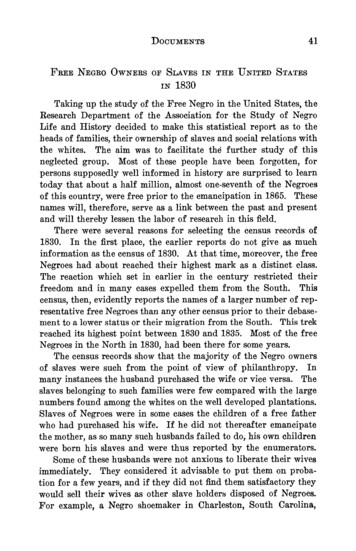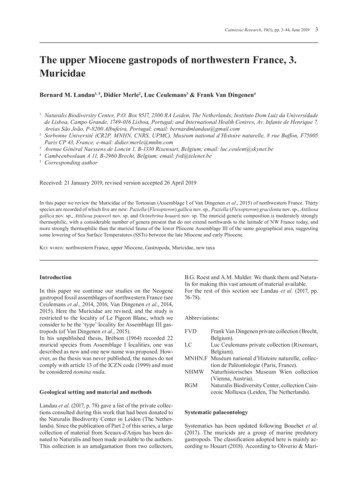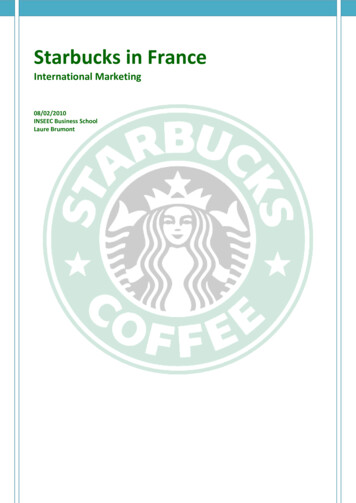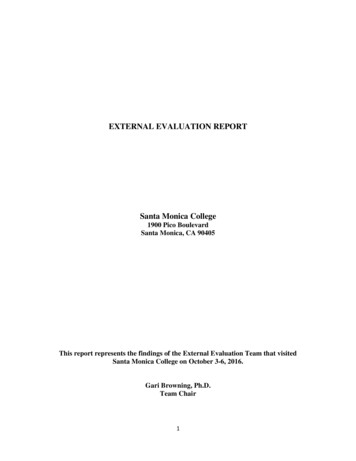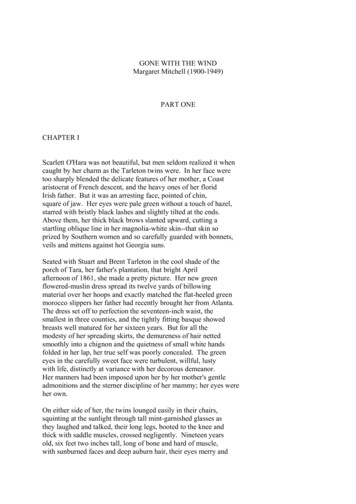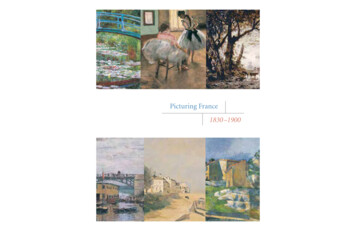
Transcription
Picturing France1830 –1900
Picturing France1830 – 1900N at i o n a l G a l l e ry o f A rt, Wa s h i ng t o n
CONTENTS1INTRODUCTION5SECTION 1111314182031373941424345515758616573Paris and the Painters of Modern LifeA modern cityA most modern old bridgeDepartment storesThe Louvre and TuileriesMontmartreSECTION 2Encounters with Nature in the Forest of FontainebleauThe Barbizon schoolA feel for lightThe academic tradition and Salon paintingPhotography and paintingOaks, artists, and nature preservesMonet in FontainebleauSECTION 3Life and Leisure along the Rivers of the Île-de-France“Impressionism”Monet’s dahliasRiver sportsPeasantsSECTION 4Rugged Landscapes in Auvergne and Franche-Comté81 Courbet on realism838792939898103SECTION 5Painters and Tourists in NormandyPlein-air paintingChannel resortsMonet and the paintings of Rouen cathedralNeo-impressionismColor and lightSECTION 6Seeking the “Primitive” in Brittany106 Celtic culture: language, music, and religion110 Synthétisme121124124124127132SECTION 7Occitan and LanguedocPétanqueThe mistralCézanne and modern artThe influence of Japanese artRESOURCES138142143145Effects of the Sun in ProvenceGlossaryNotesBibliographyList of Images
page CHE-COMTÉ5AUVERGNE6PROVENCE
INTRODUCTIONPicturing FranceFrom about 1830 to the end of the nineteenth century, a period of enormous politicaland social change, French landscape painting was transformed. Previously, French artistshad rarely painted the French countryside. The academic tradition of historical landscapewas firmly rooted in Italy. But the painters included in this teaching packet were newlyinspired by their own place and time. A number of things contributed to this change.Romanticism helped focus interest on nature, not simply as a backdrop for historicalnarrative, but as a subject worthy in and of itself. A naturalist trend helped foster lessidealized depictions that were honest portrayals of the real world. At the same time, travelaround France became much easier with the arrival of railroads and more common withthe growth of a tourist culture.It might seem obvious that landscape painting would entailpainting outdoors, but as our period opens, artists produced onlystudies en plein air (in the open air), not fully formed paintings.They used these studies, often with notes, to produce more polished pictures in their studios. But this situation, too, was rapidlychanging, and we can follow the evolution of plein-air painting asthe century progressed.A sense of place is not achieved by “scapes”—whether land, city,or sea—alone. Place is defined by society as well. So, we look atpeople, too, and examine how their lives were altered with thedramatic changes of the nineteenth century. We have already mentioned the railroad; it is only one aspect of increasing industrialization in France. Huge numbers of people moved from rural areasinto cities, and particularly to Paris. Agriculture was a deeply feltpart of the French national identity. Loss of peasant farmers fromthe countryside was troubling and at times created economic crisesin rural areas. The nineteenth century was a period of centralization in France—a natural impulse, perhaps, of the autocraticregimes that governed for most of it. Old provincial prerogativeswere marginalized as officials in Paris strove to standardize cultureand education; regional languages, like those in Brittany and theMidi, for example, were discouraged. At the end of the nineteenthcentury, regionalist movements emerged in several parts of thecountry to protect and promote local traditions.Drawing on the strengths of the National Gallery of Art collection,we focus largely on Normandy, Brittany, Provence, and the Îlede-France; in fact, we divide the Île-de-France into three separatesections: Paris, Fontainebleau, and the river towns. Our packet doesnot represent all regions of France comprehensively—we have noworks from the southwest, Corsica, or Alsace-Lorraine, or fromthe great wine-producing areas. We look at a single painting fromAuvergne and only two from Franche-Comté. Nevertheless, in thecourse of this journey around France, we encounter most of thestyles—from realism to post-impressionism—and many of thegreatest artists who flourished in the nineteenth century. This isnot meant to be a survey of French painting or even a collection of“greatest hits.” Instead, we present a discussion of artists by regionin an effort to explore how they represented a new sense of placeand time.Different artists, of course, were drawn to paint in various localesfor very different reasons. Some were lured by scenery andaesthetics, others by solitude or personal connection to a place,some by market forces. Several of the artists we look at worked inmany different places—Monet, for example, was exceptionallywell traveled. Others, like Cézanne, limited their sights (and sites)more narrowly.
page 2This booklet is organized by region, but there are many waysto approach your tour of France. Here are a few alternative“itineraries” you might consider:the impact of industrialization and technology, includingphotography and new art materials, on painting andpainting practicesthe rise of landscape paintingregional traditions and artists’ responses to themthe development of plein-air paintingthe effects of transportation and tourism on artists and theart marketconnections between earlier artists, impressionists, andpost-impressionistsartists’ public and personal connections to placethe encroaching presence of the city on the countrysideA view of Paris, looking west to the Eiffel Tower, after 1889National Gallery of Art Library, Washington, Image Collections, Gramstorff Archive
Picturing FranceCD 1Adrien TournachonFrench, 1825–1903Adrien Tournachon was the younger brotherof Gaspard-Félix Tournachon, a well-knownartist and caricaturist whose work appearedin numerous satirical newspapers under thepseudonym, Nadar. The two collaboratedbriefly after Adrien opened a photographicstudio, but competitive tensions arose in1855. Adrien hoped to continue the practice alone as “Nadar jeune,” but a courtruled that Félix, who was the better knownand more accomplished photographer,was “the only, the true Nadar.” Years laterNadar’s studio would be the site of the firstimpressionist exhibition.Vache Garonnaise, âgée de 5 à 6 ans, 1856Gelatin coated salted paper print from collodion negativemounted on paperboard, sheet: 8 1 16 x 11 1 4 in.In 1856 and again in 1860, Adrien madea series of photographs of prize-winninglivestock at the agricultural fairs in Paris.To photograph animals that rarely stoodstill longer than a few seconds, he usedthe more rapid collodion wet plate processrather than the slower paper negative process he had used previously. At the 1856livestock show, Tournachon succeededin making more than 120 negatives, andprinted around 50 of them to be includedin an album presented to the minister ofagriculture and commerce in July 1856.page 3National Gallery of Art, WashingtonAnonymous Gift 2000.122.3This photograph of a prize-winning cowfrom the Garonne region was printed in thetechnique known as vernis-cuit, in whichthe paper is coated with layers of gelatinand tannin to give the surface the appearance of varnished leather. This image ofan impressive farm animal celebrated anagrarian way of life, even as the urbanstructure of the French capital was beingredesigned and “modernized.”
SECTION 1PicturingFranceParis and the Paintersof Modern LifeAn influential essay published by poet andcritic Charles Baudelaire in 1863, titled“The Painter of Modern Life,” exhortedartists to abandon the biblical figures andRoman heroes, the innumerable Venuses,who had long populated the walls of theSalon and instead to take their subjectsfrom the life around them. Only in thecontemporary world were authentic locifor real art to be found — and the epicenterof that world was Paris. Critic and historianWalter Benjamin called it “the capital of thenineteenth century.”K. Baedeker, Paris and Environs (Leipzig, 1910)National Gallery of Art Library, Washington
page 6The city was much changed from what it had been in the early1800s. Between about 1830 and 1890, the population of Parisincreased fourfold, as people from rural areas moved to France’spolitical, cultural, and economic center. In the early 1850s,Napoleon III appointed Baron Georges Haussmann to devisea master plan for the city, giving him a broad mandate and fundsfor its modernization and revitalization. Haussmann’s plan calledfor the destruction of 30,000 dwellings and the displacement of300,000 people to make way for new railway stations, bridges,CD 2Maxime LalanneFrench, 1827–1886and public monuments. The cramped and irregular streets of theolder city were replaced with the wide, tree-lined boulevards thatwe associate with Paris today.The archetypal denizen of the new, modern boulevard was a flâneur(from flâner, to stroll), a man (always, a man) of sophistication andelegance who scanned the activity around him with detachment,even irony. Baudelaire cast the artist in the role of flâneur, a detective who could decipher the codes of a new urban experience.Demolition for the Opening of the rue des Écoles(Démolitions pour le percement de la ruedes Écoles), unknown dateEtching, plate: 9 3 8 x 12 1 2 in.National Gallery of Art, WashingtonAilsa Mellon Bruce Fund 1974.69.78
Paris and the Painters of Modern LifeCD 3Charles MarvilleFrench, 1816–c. 1879Rue Saint-Jacques (detail), 1865/1869Albumen print from collodion negative,12 1 8 x 10 5 8 in.This photograph, an albumen print madefrom a collodion glass negative, depicts anintersection near the Sorbonne universityin the heart of the medieval Latin Quarter.Made for documentary purposes —Marvillewas hired by the government to record theold city—it not only captures the street’sarchitectural character and condition, butalso sensitively describes the light floodingthrough the narrow passageway and lingerson the contrast between the bold letteringof advertisements and the damp, peelingwalls that threaten to absorb them. Whilethe photograph at first appears to be devoidpage 7National Gallery of Art, WashingtonAnonymous Gift and Gift of Joyce andRobert Menschel 2003.17.1of human presence, a closer look revealsseveral figures—one standing under thestreet light and another leaning out a nearbybalcony—who stood still long enough duringthe exposure to register on the negative.
page 8Background: ParisSettingHistoryTodayParis occupies a slight bowl along an arc ofthe Seine and includes two islands in theriver: Île de la Cité and Île Saint-Louis.When Julius Caesar conquered Paris in 52BC, it was a small fishing village on the Îlede la Cité; the name Paris comes from theParisii, the local Gallic tribe.The metropolitan population of Paris in2004 was approximately 11.5 million;this includes about 30 percent of all whitecollar workers in France and more than 18percent of the entire French population.The river divides the city into the Left Bankand Right Bank.The commune of Paris is about 105 km2(about 40 sq. mi.) but the greater metropolitan area extends far beyond to roughly14,500 km2 (5,600 sq. mi.).The highest point, in Montmartre, is 130 m(425 ft.) above sea level.The city is divided into 20 numberedarrondissements (boroughs), which spiralclockwise from Île de la Cité.Under Charlemagne Paris became a majorcenter of learning, but it was not untilHugh Capet, Count of Paris, became thefirst Capetian king that the city was firmlyestablished as France’s capital.As the power and reach of the Frenchkings grew, so did the influence of Paris inFrench life.The heart of medieval Paris occupiesthe two islands and the Left Bank’s LatinQuarter, where the university drew suchscholars as Thomas Aquinas.The city is still symbolized by the EiffelTower, designed by Gustave Eiffel andbuilt for the 1889 World’s Fair, but newmonuments have also become familiarworldwide, including the Centre Pompidoufor contemporary art and the glass pyramids of the Grand Louvre.Paris’ first skyscraper, the TourMontparnasse, was begun in the late1960s but since then most tall buildingshave been restricted to La Défense, anarea northwest of the city center.In the 16th century, François I broughtthe Renaissance to the Louvre and thechateau at Fontainebleau.Louis XIV, distrustful of Paris, moved hiscourt to Versailles, but the city played acentral role in the Revolution.During the Franco-Prussian War(1870–1871), France was defeated andParis besieged; the Paris Commune, abloody insurrection in the spring of 1871,left more than 20,000 dead.During the Third Republic, constituted in1875, Paris was cemented as the administrative, cultural, and transportation centerthat it remains today.Explore Paris when it was a Roman city:www.paris.culture.fr (in English and French)
Paris and the Painters of Modern Lifepage 9The Worksslide 1CD 4Édouard ManetFrench, 1832–1883“It was the homeland, at ten pence a night,of all the street organ players, of all themonkey tamers, of all the acrobats andof all the chimney sweeps that swarmthe streets of the town.” Writing in 1860novelist and commentator Albéric Secondwas describing the neighborhood of PetitePologne, close to Édouard Manet’s studio.Balzac called it “sinister,” and Manethimself “a picturesque slum.” It was one ofthe many poor sections of Paris completelyrazed in Baron Haussmann’s renovations.By 1862, the date of Manet’s painting, thePetite Pologne had been cleared for construction of the boulevard Malesherbes.More than one hundred thousand peoplewere officially listed as indigent in the city,and many more were uncounted.The Old Musician, 1862Oil on canvas, 73 3 4 x 98 in.Here Manet presents a visual catalogue ofthe Petite Pologne’s displaced. Most arereal individuals. The seated musician isJean Lagrène, leader of a local gypsy bandwho earned his living as an organ-grinderand artist’s model. The man in the top hatis Cola
course of this journey around France, we encounter most of the styles—from realism to post-impressionism—and many of the greatest artists who flourished in the nineteenth century. This is not meant to be a survey of French painting or even a collection of “greatest hits.” Instead, we present a discussion of artists by region in an effort to explore how they represented a new sense of .
